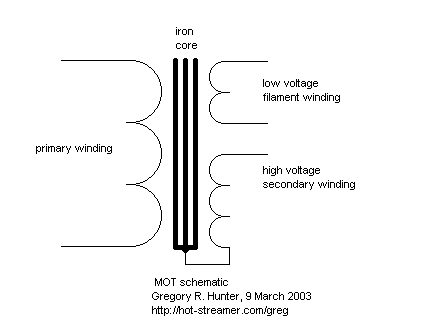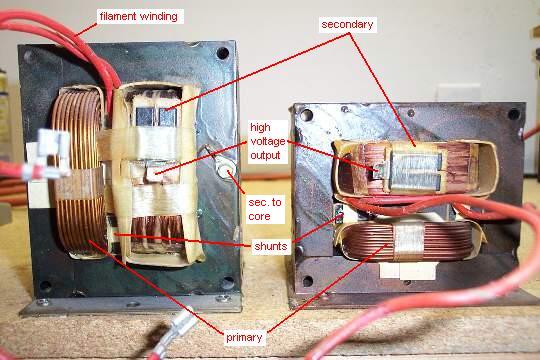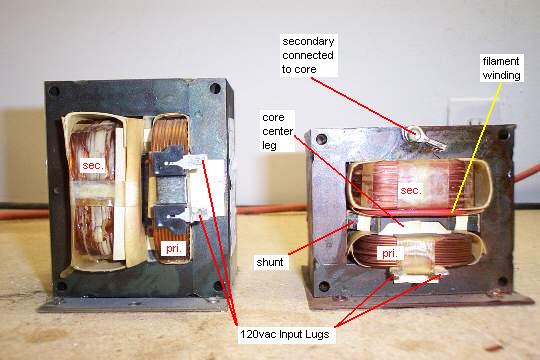
MOT Chat
I get a ton of questions about microwave oven transformers (MOTs). Maybe this will help some of you.
Standard U.S. MOTs have three coils or windings on them. Let's take inventory:
120vac primary winding (approximately 130 turns of coarse magnet wire)
~2000vac secondary winding (approximately 2200 turns of fine magnet wire)
Low voltage AC magnetron filament supply (2 or 3 turns of thick, plastic-insulated wire)
Standard U.S. MOTs typically have five electrical connectors. Let's count them:
Two male 120vac spade-type input lugs
Two female low voltage AC filament voltage output lugs (on long wire leads)
One male spade-type high voltage output lug

How can we have only one high voltage out put? Easy--the other end of the high voltage secondary winding is connected to the core. This is clearly visible in both images below. That means the ~2kvac is taken off between the high voltage lug and the core! So what, you ask? So be careful when handling MOTs, that's what! If you apply 120vac to the primary without grounding the core, the core will be "hot" with 2000vac! Never touch MOTs anywhere while they are plugged in! When using MOTs for hobby purposes, always use a 3-wire power cord and always ground the core or cores to the green ground wire. Another note: the 2000vac thing is a nominal value. The MOTs in my collection have outputs ranging from 1800vac up to 2600vac, but 2100-2200vac seems to be the most common output voltage.
These two images are a front & rear view of the same two MOTs. They are pretty self-explanatory, but I'll yak some more anyway...

Many people are unsure about what to do with the filament supply wires (fat red wires in these images). They are very low voltage and are not useful for coiling so you may ignore them. If they get in your way, you may clip them off near the core and cover the cut off ends with small plastic wire caps.

Many coilers assert that MOTs are unshunted and therefore require external current limiting (ballast). These folks are only half right. Let's settle this once and for all: MOTs are shunted. The shunts are clearly visible in these images. Furthermore, I've seen shunts in every U.S. and EU MOT that I have ever examined (and that's more than a few). I'm not always right about everything, but I'm sure that I'm right about this one thing. However, it is also true that the shunts don't seem to be very effective and that MOTs generally do require external ballast. The usual result of shorting out a MOT is a tripped circuit breaker. Interestingly enough, I'm in possesion of one small MOT that pulls only 17 amps from the wallplug when the secondary is shorted. I sometimes use it to ballast larger MOT-based power supplies.